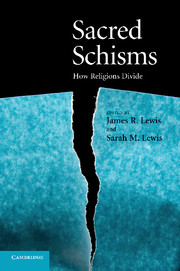Book contents
- Frontmatter
- Contents
- List of figures
- Notes on contributors
- Acknowledgments
- Introduction
- PART I THEORETICAL OVERVIEW
- PART II SURVEY OF SCHISMS IN SELECTED TRADITIONS
- PART III CHRISTIAN TRADITIONS
- PART IV WESTERN ESOTERIC TRADITIONS
- PART V NON-WESTERN/POSTCOLONIAL TRADITIONS
- 12 Succession, religious switching, and schism in the Hare Krishna movement
- 13 Schisms within Hindu guru groups: the Transcendental Meditation movement in North America
- 14 Schism in Babylon: colonialism, Afro-Christianity and Rastafari
- Index
- References
12 - Succession, religious switching, and schism in the Hare Krishna movement
Published online by Cambridge University Press: 24 October 2009
- Frontmatter
- Contents
- List of figures
- Notes on contributors
- Acknowledgments
- Introduction
- PART I THEORETICAL OVERVIEW
- PART II SURVEY OF SCHISMS IN SELECTED TRADITIONS
- PART III CHRISTIAN TRADITIONS
- PART IV WESTERN ESOTERIC TRADITIONS
- PART V NON-WESTERN/POSTCOLONIAL TRADITIONS
- 12 Succession, religious switching, and schism in the Hare Krishna movement
- 13 Schisms within Hindu guru groups: the Transcendental Meditation movement in North America
- 14 Schism in Babylon: colonialism, Afro-Christianity and Rastafari
- Index
- References
Summary
Studies of disengagement from new religions have treated defection largely as an individual experience that involves a breakdown in the ideological and cognitive linkage between a convert's values and beliefs and the religious doctrines and practices of the group. Defection thus becomes an act of “falling from the faith” (Bromley 1988). Yet as new religions develop, internal conflict and factionalism produce mass expulsion, group defection, religious switching, and schism (Chancellor 2000; Ofshe 1980; Rochford 1989; 2007a; Rochford and Bailey 2006; Wallis 1976; 1979; 1982; Wright 1988). Some or all of these outcomes are especially likely upon the death of a charismatic founder, should the departed leader fail to authorize an alternative system of authority (Leatham 2003; Miller 1991; Rochford 1989; 1998a; 2007a; Wallis 1979: 187; Zald and Ash Garner 1987: 136).
Beginning in 1977, the International Society for Krishna Consciousness (ISKCON), more widely known as the Hare Krishna movement, experienced ongoing succession problems after the death of its founder, A. C. Bhaktivedanta Swami Prabhupada. Ideological conflict over the behavior of Prabhupada's successors and the basis of organizational authority caused large numbers of devotees to abandon ISKCON's communities in North America, western Europe, and other locations worldwide. Because, in most cases, those disaffiliating remained committed to their Krishna conscious beliefs, many sought alternative sources of authority to Prabhupada's successors. While some joined related Krishna-based religious organizations, others stood their ground and pushed to change ISKCON's system of religious authority.
- Type
- Chapter
- Information
- Sacred SchismsHow Religions Divide, pp. 265 - 286Publisher: Cambridge University PressPrint publication year: 2009
References
- 2
- Cited by



